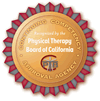Brachial Plexus Birth Injuries: Improving Functional Outcomes from Infancy through Adolescence
This live interactive webinar (via Zoom) provides an overview of conservative and surgical management of Brachial Plexus Birth Injury, with a primary focus on providing a comprehensive therapeutic approach to improve outcomes for infants through adolescents.
Participants will:
- be presented with a detailed overview of the anatomy of the initial nerve injury and the muscular and bony sequelae that often results in lifelong neuromuscular and orthopedic challenges.
- gain a detailed understanding of surgical interventions, non-surgical medical interventions, and radiological tests, enabling them to make appropriate medical referrals.
- learn comprehensive examination and intervention strategies for each stage of recovery throughout infancy, childhood, and teen years.
This live webinar CE course includes video-recorded patient demonstrations highlighting specific examination tools and intervention strategies, including traditional interventions as well as the use of state-of-the art technology. Strategies for family support and intervention will also be discussed.
Course content is not intended for use by any participants outside the scope of their license or regulation.
Please read course requirements carefully before registering for this course. Webinar courses are final sale and are not refundable. 7.5 contact hour live webinar via Zoom. To earn CE credits for this webinar, you must attend the entire session on both days.
Course requirements:
- computer /tablet with webcam, speakers, microphone (or smartphone)
- reliable internet access
- completion of post-test with a passing score of 80% or higher
- email access to receive course communications
- ability to download files (printing optional)
By the end of this course, participants will:
- identify the probable location and severity of a brachial plexus injury when presented with a newborn diagnosed with Brachial Plexus Birth Injury by a medical professional.
- identify three complications of a Brachial Plexus Birth Injury on normal shoulder girdle anatomy.
- identify three developmental motor patterns that may result in worsening of the injury and should be adapted on children with a Brachial Plexus Birth Injury.
- develop a treatment plan for a newborn with Brachial Plexus Birth Injury based on knowledge of shoulder girdle anatomy and developmental progressions.
- identify and explain two surgical options for improving the self-care skills of a teen diagnosed with Brachial Plexus Birth Injury.
- choose and justify an appropriate evaluation tool to assess levels of function in multiple areas for a given case scenario.
- develop a treatment plan, based on the course treatment paradigm in combination with results of assessment, that would be appropriate for a child with Brachial Plexus Birth Injury.
- choose 3 treatment modalities based on a given case scenario of a child with Brachial Plexus Birth Injury.
Session One
Overview of Brachial Plexus Birth Injury (45 minutes)
Impact of Brachial Plexus Birth Injury on Shoulder Girdle Anatomy (45 minutes)
Developmental Apraxia related to Brachial Plexus Birth Injury (45 minutes)
Break (15 minutes)
Brachial Plexus Birth Injury in the Newborn (0‐3 months) (45 minutes)
Surgical Interventions for Brachial Plexus Birth Injury throughout Childhood (45 minutes)
Session Two
Therapeutic Examination and Evaluation (105 minutes)
Break (15 minutes)
Intervention Principles for Brachial Plexus Birth Injury (90 minutes)
Intensive Case Study (30 minutes)
7.5 Contact Hours (7.5 clock hours) synchronous learning
This course content is not intended for use by any participants outside the scope of their license or regulation.
This live interactive webinar course is accepted by many professional credentialing organizations and state professional regulatory boards. Rules and regulations change frequently without notification, and apply differently to live and online courses. Please check with your state board to confirm accuracy of this list and acceptance of contact hours. Certificate of Attendance will be issued to all participants upon completion of the course and may be used for CEU verification of credits.
CE credits vary by state. Please check with your state board/certifying agency to confirm conversion of contact hours to CEUs.
Rehab Education, LLC is recognized as:
- approved provider of PT and PTA continuing education by the NY State Education Department Board of Physical Therapy.
- approved provider of PT and PTA continuing education by IDFPR/ Illinois Board of Physical Therapy (#216000227).
 American Occupational Therapy Association (AOTA): Rehab Education, LLC is an AOTA Approved Provider (#6177) of professional development. This Distance Learning-Interactive CE course is offered at 0.75 CEU (7.5 contact hours) Intermediate level | OT Service Delivery/Foundational Knowledge. The assignment of AOTA CEUs does not imply endorsement of specific course content, products, or clinical procedures by AOTA or indicate AOTA approval of a certification or other professional recognition. Approval #05974. (Course must be taken prior to 1-10-2028.)
American Occupational Therapy Association (AOTA): Rehab Education, LLC is an AOTA Approved Provider (#6177) of professional development. This Distance Learning-Interactive CE course is offered at 0.75 CEU (7.5 contact hours) Intermediate level | OT Service Delivery/Foundational Knowledge. The assignment of AOTA CEUs does not imply endorsement of specific course content, products, or clinical procedures by AOTA or indicate AOTA approval of a certification or other professional recognition. Approval #05974. (Course must be taken prior to 1-10-2028.)
Arkansas Physical Therapy Association: This course has been approved by the Arkansas APTA for 7.5 contact hours. Approval #APTA-AR 2011
California OT Board: This course and instructor have been approved by the CA Board of OT for 7.5 contact hours of post-professional education in the advanced practice area of hand therapy. Approval #22-H30.
 Physical Therapy Board of California: The Physical Therapy Board of California recognizes Rehab Education, LLC as an approval agency to approve providers offering continuing competency courses for CA licensed PTs and PTAs. This course is approved for 7.5 contact hours (synchronous learning)
Physical Therapy Board of California: The Physical Therapy Board of California recognizes Rehab Education, LLC as an approval agency to approve providers offering continuing competency courses for CA licensed PTs and PTAs. This course is approved for 7.5 contact hours (synchronous learning)
Illinois State Board of Physical Therapy: Approved CE Sponsor by Illinois State Board of Physical Therapy, Division of Professional Regulations, Approval #216.000227. (Course must be taken prior to 09-30-2026)
NY State Physical Therapy Board: Rehab Education, LLC is recognized as an approved provider of PT and PTA continuing education by the NY State Education Department Board of Physical Therapy. (Course must be taken prior to 05-10-2025)
Fast Facts
Skill Level: Beginner/Intermediate
Delivery Method: Live Interactive Webinar (synchronous learning)
CE: 7.5 contact hours (synchronous learning)
Who Should Attend:
- Occupational Therapists
- Occupational Therapy Assistants
- Physical Therapists
- Physical Therapist Assistants
- Certified Hand Therapists
- Registered Nurses
Online, Live Zoom:
Course consists of two 4-hour live webinars!
During registration, select one of the following groups:
Instructors:
Cindy Servello, MA, OTR/L
 has been a practicing pediatric occupational therapist for the last forty-five years. Over the last twenty years, she has developed a specialty expertise in the treatment of infants and children with obstetric brachial plexus injuries. In addition to being the primary therapist for The Neonatal Brachial Plexus Center in New Jersey with a group of pediatric neurologists, she has served as the National Therapist Consultant for the Texas Nerve and Paralysis Institute where her responsibilities included consultation to therapists, parents, and physicians, primary involvement in clinics nationally in coordination with top level surgeons and brachial plexus specialists, and participation in brachial plexus seminars which address state-of-the-art surgical and treatment interventions. She continues to consult with surgeons, therapists, and parents both nationally and internationally as well as providing educational webinars to parents and therapists.
has been a practicing pediatric occupational therapist for the last forty-five years. Over the last twenty years, she has developed a specialty expertise in the treatment of infants and children with obstetric brachial plexus injuries. In addition to being the primary therapist for The Neonatal Brachial Plexus Center in New Jersey with a group of pediatric neurologists, she has served as the National Therapist Consultant for the Texas Nerve and Paralysis Institute where her responsibilities included consultation to therapists, parents, and physicians, primary involvement in clinics nationally in coordination with top level surgeons and brachial plexus specialists, and participation in brachial plexus seminars which address state-of-the-art surgical and treatment interventions. She continues to consult with surgeons, therapists, and parents both nationally and internationally as well as providing educational webinars to parents and therapists.
What Students are Saying:
“Loved that we tackled a complex kiddo. Great reminder of balancing our “excitement” as therapists (to try many options to normalize alignment) with the day-to-day needs/wants of a family. Really appreciated the various points of view and multiple suggestions from all the participants .“
“Absolutely excellent. Many of the interventions I had heard of but never seen them used in such a thorough way.”

 American Occupational Therapy Association (AOTA): Rehab Education, LLC is an AOTA Approved Provider (#6177) of professional development. This Distance Learning-Interactive CE course is offered at 0.75 CEU (7.5 contact hours) Intermediate level | OT Service Delivery/Foundational Knowledge. The assignment of AOTA CEUs does not imply endorsement of specific course content, products, or clinical procedures by AOTA or indicate AOTA approval of a certification or other professional recognition. Approval #05974. (Course must be taken prior to 1-10-2028.)
American Occupational Therapy Association (AOTA): Rehab Education, LLC is an AOTA Approved Provider (#6177) of professional development. This Distance Learning-Interactive CE course is offered at 0.75 CEU (7.5 contact hours) Intermediate level | OT Service Delivery/Foundational Knowledge. The assignment of AOTA CEUs does not imply endorsement of specific course content, products, or clinical procedures by AOTA or indicate AOTA approval of a certification or other professional recognition. Approval #05974. (Course must be taken prior to 1-10-2028.) Physical Therapy Board of California: The Physical Therapy Board of California recognizes Rehab Education, LLC as an approval agency to approve providers offering continuing competency courses for CA licensed PTs and PTAs. This course is approved for 7.5 contact hours (synchronous learning)
Physical Therapy Board of California: The Physical Therapy Board of California recognizes Rehab Education, LLC as an approval agency to approve providers offering continuing competency courses for CA licensed PTs and PTAs. This course is approved for 7.5 contact hours (synchronous learning)